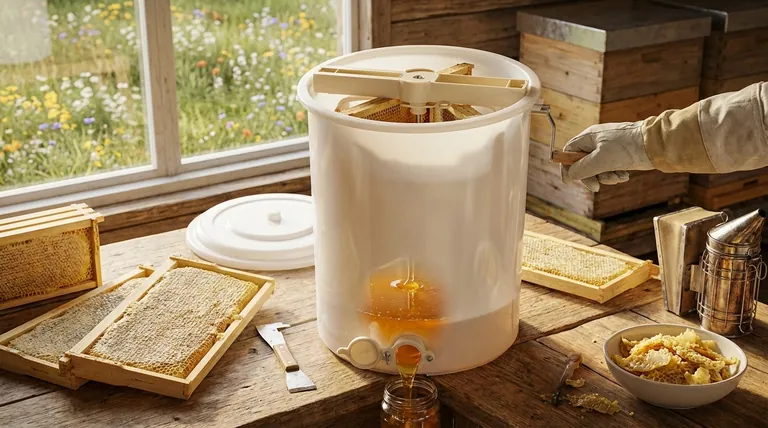For the hands-on beekeeper, a manual honey extractor offers three distinct advantages: greater control, lower cost, and complete independence from a power source. This combination makes it a highly practical tool for hobbyists and small-scale apiarists who prioritize a gentle, deliberate extraction process and a direct connection to their craft.
The decision between a manual and an electric honey extractor is not about which is universally "better," but which tool best aligns with your specific goals. Manual extractors excel in control and affordability for small operations, while electric models are built for speed and efficiency at a larger scale.

The Core Benefits of Manual Extraction
A manual extractor operates using a hand crank to generate centrifugal force, pulling honey from the comb. While the principle is simple, the benefits are significant for a certain type of beekeeper.
Absolute Control Over the Process
With a manual crank, you are in direct command of the extraction speed and direction. This tactile feedback allows you to start slowly and ramp up speed gently.
This level of control is crucial for preventing "blowouts," where the force of extraction destroys the delicate wax comb. It is especially beneficial when working with new or fragile combs.
Cost-Effectiveness for the Hobbyist
Manual extractors represent a significantly lower initial investment compared to their electric counterparts. This makes them an accessible entry point for beginners or beekeepers managing just a few hives.
For those not yet committed to large-scale honey production, a manual model provides full functionality without the high upfront cost of a motorized unit.
Independence From the Grid
Because they require no electricity, manual extractors offer unmatched portability. You can extract honey directly in your apiary, in a remote shed, or anywhere you can carry the equipment.
This freedom from power cords and outlets is a major advantage for beekeepers with hives located far from a reliable power source.
The Tactile Connection
Many beekeepers are drawn to the practice for its hands-on, natural feel. A manual extractor enhances this connection.
The physical act of cranking the drum and feeling the subtle shifts as the honey is released fosters an intimate involvement in the process that many hobbyists find deeply rewarding.
Understanding the Trade-offs: Manual vs. Electric
To make an informed choice, you must weigh the benefits of a manual extractor against its inherent limitations, especially when compared to an electric model.
The Cost of Speed and Scale
The primary trade-off is efficiency. An electric extractor can process a large number of frames significantly faster than a manual one.
What might take hours of physical cranking with a manual extractor could be done in a fraction of the time by simply flipping a switch on an electric model. This makes electric extractors the clear choice for medium to large-scale operations.
The Physical Demand
Operating a manual extractor requires consistent physical effort. While not overly strenuous for a few frames, extracting honey from multiple hives can become a serious workout.
Beekeepers with physical limitations or those who wish to minimize labor should strongly consider an electric model, which completely eliminates the manual effort of spinning the frames.
Efficiency at Volume
As your apiary grows, the time and labor saved by an electric extractor quickly begin to justify its higher cost. Manually processing honey from five, ten, or more hives can become a bottleneck in your entire operation.
Making the Right Choice for Your Apiary
Your decision should be guided by a realistic assessment of your goals, scale, and personal preferences.
- If your primary focus is starting out with 1-3 hives on a budget: A manual extractor is the most practical and economical choice to get started.
- If your primary focus is the hands-on craft and portability: The control and grid independence of a manual extractor perfectly align with your beekeeping philosophy.
- If your primary focus is scaling up to 5+ hives or you have physical limitations: An electric extractor's efficiency will save significant time and labor, making it a worthwhile investment.
Choosing the right extractor is about aligning your equipment with the scale and style of your beekeeping journey.
Summary Table:
| Advantage | Key Benefit | Ideal For |
|---|---|---|
| Greater Control | Gentle extraction to prevent comb damage | Hobbyists & fragile combs |
| Lower Cost | Affordable entry point for small operations | Beginners & budget-conscious beekeepers |
| No Power Needed | Complete portability and grid independence | Apiaries in remote locations |
Ready to find the perfect extractor for your apiary? At HONESTBEE, we supply high-quality beekeeping supplies and equipment directly to commercial apiaries and distributors. Whether you're starting with a manual model or scaling up to electric, our wholesale-focused operations ensure you get the right tools for your needs. Contact our team today to discuss your requirements and get a quote!
Visual Guide

Related Products
- Plastic Hand Crank 2 Frame Honey Extractor Low Price
- 6 Frame Manual Stainless Steel Honey Extractor Beekeeping Equipment
- HONESTBEE 3-Frame Manual Acrylic Honey Extractor
- 2 Frame Stainless Steel Manual Honey Spinner Extractor for Beekeeping
- Easy Use Manual Stainless Steel Honey Press for Honey Comb
People Also Ask
- What tips can maximize honey extraction efficiency? Unlock Higher Yields and Purer Honey
- Can manual honey extractors effectively remove honey from cells? A Guide for Small-Scale Beekeepers
- How do you extract honey by hand? A Guide to Crush & Strain vs. Manual Extractor
- What are the advantages of manual honey extractors? Ideal for Hobbyist & Small-Scale Beekeepers
- What equipment is used for honey harvesting? Build Your Perfect Harvesting Toolkit



















